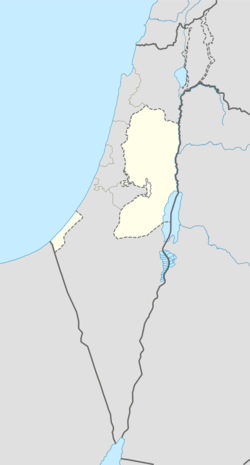Tell es-Sanam
| Alternative name | Tell es-Sannam, Tell al-Sannam, Tall as Sanām |
|---|---|
| Location | Palestine |
| Coordinates | 31°27′48.6″N 34°23′3.1″E / 31.463500°N 34.384194°E |
| History | |
| Periods | Late Bronze Age and Iron Age |
| Management | Private ownership[1] |
Tell es-Sanam is a tell (a mound created by accumulation of debris) near the Mediterranean coast of the Gaza Strip in Palestine. It is located on the bank of the Wadi Ghazzeh, near the point where the watercourse meets the Mediterranean Sea.[2] Archaeologists Joanna Clarke and Louise Steel hypothesise that Tell es-Sanam may have been established in the 2nd millennium BCE as a successor to the Bronze Age settlement at Tell el-Ajjul a short distance away as the Wadi Gazzeh silted up; its position near the sea would have enabled to it function as a port.[3]

The Gaza Research Project found Iron Age pottery during preliminary investigations,[4] and Eliezer Oren reported finding Late Bronze Age pottery at Tell es-Sanam in the 1970s.[5] Clarke and Steel also suggest that during the Iron Age the settlements at Tell es-Sanam and Tell Ruqeish may have been more important in the region than the settlement at Gaza.[6] Between 2005 and 2014, the area around the archaeological site changed significantly with the construction of industrial buildings and craters nearby from the 2014 Gaza War.[7] Archaeologist Michael Press suggests that a 10 feet (3.0 m) marble statue of Zeus found in 1879, and it is from this discovery that the site gets its name which in Arabic means "the mound of the idol".[8]
References
[edit]- ^ Centre for Cultural Heritage Preservation 2025, p. 323.
- ^ Morhange et al. 2005, p. 78.
- ^ Clarke & Steel 1999, pp. 223, 226.
- ^ Clarke & Steel 1999, p. 223.
- ^ Clarke & Sadeq 2004, p. 36.
- ^ Clarke & Steel 2000, p. 191.
- ^ Andreou et al. 2024, pp. 22–23.
- ^ Press 2016.
Bibliography
[edit]- Andreou, Georgia M.; Fradley, Michael; Blue, Lucy; Breen, Colin (2024). "Establishing a baseline for the study of maritime cultural heritage in the Gaza Strip". Palestine Exploration Quarterly. 156 (1): 4–42. doi:10.1080/00310328.2022.2037923.
- Centre for Cultural Heritage Preservation (January 2025). Damage and Risk Assessment of Cultural Heritage Under Attack in the Gaza Strip (PDF) (Report). State of Palestine Ministry of Tourism and Antiquities.
- Clarke, Joanna; Sadeq, Moain (2004), "Gaza Research Project: 1998 Survey of the Old City of Gaza", Levant, 36: 31–36, doi:10.1179/lev.2004.36.1.31
- Clarke, Joanna; Steel, Louise (1999), "Demographic patterns and differential settlement in the Bronze Age landscape of Palestine" (PDF), The landscape of Palestine: equivocal poetry, pp. 211–231, hdl:20.500.11889/4685
- Clarke, Joanna; Steel, Louise (2000), "Reports: The Gaza Research Project 1998", Palestine Exploration Quarterly, 132 (2): 189–191, doi:10.1179/peq.2000.132.2.189
- Morhange, Christophe; Hamdan Taha, Mohamed; Humbert, Jean-Baptiste; Marriner, Nick (2005), "Human settlement and coastal change in Gaza since the Bronze Age", Méditerranée, 104 (104): 75–78, doi:10.4000/mediterranee.2252
- Press, Michael (6 September 2016). "A 10-Foot Marble Zeus in Nineteenth-Century Gaza". Archived from the original on 5 December 2021. Retrieved 2 July 2025.


